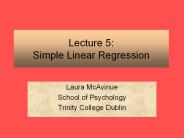Linear Least Squares QR Factorization - PowerPoint PPT Presentation
1 / 15
Title:
Linear Least Squares QR Factorization
Description:
Linear Least Squares QR Factorization Systems of linear equations Problem to solve: M x = b Given M x = b : Is there a solution? Is the solution unique? – PowerPoint PPT presentation
Number of Views:21
Avg rating:3.0/5.0
Title: Linear Least Squares QR Factorization
1
Linear Least Squares QR Factorization
2
(No Transcript)
3
Systems of linear equations
- Problem to solve M x b
- Given M x b
- Is there a solution?
- Is the solution unique?
4
Systems of linear equations
- Find a set of weights x so that the weighted sum
of the - columns of the matrix M is equal to the right
hand side b
5
Systems of linear equations - Existence
A solution exists if
There exist weights, x1, ., xN, such that
- A solution exists when b is in the span of the
columns of M
6
Systems of linear equations - Uniqueness
Suppose there exist weights, y1, ., yN, not all
zero, such that
Then Mx b ? Mx My b ? M(xy) b
A solution is unique only if the columns of M
are linearly independent.
7
QR factorization 1
- A matrix Q is said to be orthogonal if its
columns are orthonormal, i.e. QTQI. - Orthogonal transformations preserve the Euclidean
norm since - Orthogonal matrices can transform vectors in
various ways, such as rotation or reflections but
they do not change the Euclidean length of the
vector. Hence, they preserve the solution to a
linear least squares problem.
8
QR factorization 2
- Any matrix A(mn) can be represented as
- A QR
- ,where Q(mn) is orthonormal and R(nn) is upper
triangular
9
QR factorization 2
- Given A , let its QR decomposition be given as
AQR, where Q is an (m x n) orthonormal matrix
and R is upper triangular. - QR factorization transform the linear least
square problem into a triangular least squares. - QRx b
- Rx QTb
- xR-1QTb
Matlab Code
10
Normal Equations
- Consider the system
- It can be a result of some physical measurements,
which usually incorporate some errors. Since, we
can not solve it exactly, we would like to
minimize the error - rb-Ax
- r2rTr(b-Ax)T(b-Ax)bTb-2xTATbxTATAx
- (r2)x0 - zero derivative is a (necessary)
minimum condition - -2ATb2ATAx0
- ATAx ATb Normal Equations
11
Normal Equations 2
- ATAx ATb Normal Equations
12
Least squares via AQR decomposition
- A(m,n)Q(m,n)R(n,n), Q is orthogonal, therefore
QTQI. - QRxb
- R(n,n)xQT(n,m)b(m,1) -well defined linear
system - xR-1QTb
- Q is found by GramSchmidt orthogonalization of
A. How to find R? - QRA
- QTQRQTA, but Q is orthogonal, therefore QTQI
- RQTA
- R is upper triangular, since in orthogonalization
procedure only - a1,..ak (without ak1,) are used to produce qk
13
Least squares via AQR decomposition 2
- Let us check the correctness
- QRxb
- RxQTb
- xR-1QTb
14
Last lecture reminderQR Factorization By
picture
15
QR Factorization Minimization ViewMinimization
Algorithm
For i 1 to N For each Target Column
For j 1 to i-1 For each Source Column left
of target end end
Orthogonalize Search Direction
Normalize































